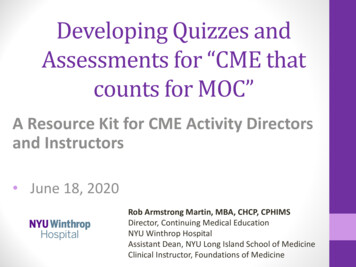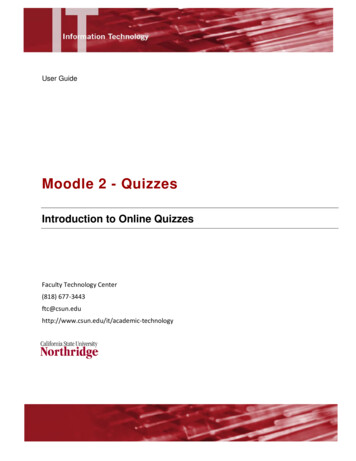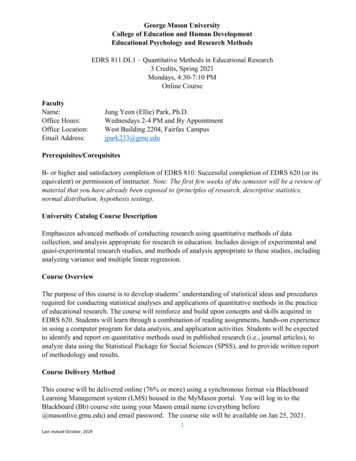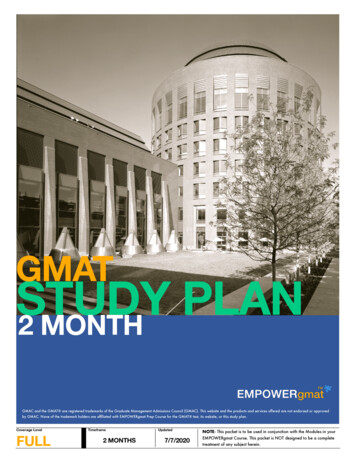
Transcription
Developing Quizzes andAssessments for “CME thatcounts for MOC”A Resource Kit for CME Activity Directorsand Instructors June 18, 2020Rob Armstrong Martin, MBA, CHCP, CPHIMSDirector, Continuing Medical EducationNYU Winthrop HospitalAssistant Dean, NYU Long Island School of MedicineClinical Instructor, Foundations of Medicine
Developing Quizzes & Assessmentsfor “CME that counts for MOC”Contents:1. Roadmap of technical elements required in MOCquestions2. Suggested Practices for question-writing inMOC/CME3. Templates that question authors can use4. Peer Reviewer Form to document adherence toquestion Review Process
Introduction: What to Assess? When writing assessment instruments, Start with the end inmind: What kind of learner does your target audience include? What specialty ? What learning outcomes do you need to measure? Ability to recall facts (test of Memorization) Ability to synthesize concepts (test of using multiple facts) Ability to Practice Competence (What would you do in thiscase?) MOC-credit assessments can measure Medical Knowledge,Practice Assessment, Self Assessment, or Patient Safety. What style of question do you or your speakers feel bestmeasures your Learning Objectives?
Best Practices and Pitfalls:multiple choice test-item writing:1. Offer four answer choices that are of similarlength and detail.Good Example:Bad example:
Best Practices and Pitfalls:multiple choice test-item writing:2. Avoid Order-dependent answersWhy? We may need to alphabetize or randomizethe choice order, so numbering may change.Bad Example ( “A and C only”)Good Example
Best Practices and Pitfalls:multiple choice test-item writing:3. Avoid Combination answers (“A and D”) etc. Combination choices impose extra cognitive loadand only indirectly measure the learning objective Good Example Bad Example
Best Practices and Pitfalls:multiple choice test-item writing:4. Half right should not be scored as all wrong-Restructure combination answers into partial creditchoices Good Example Bad Example
Best Practices and Pitfalls:multiple choice test-item writing:5. Avoid “All/None” answers: these steer the learnerand shortcut their full consideration of the optionschoices.
Best Practices and Pitfalls:multiple choice test-item writing:6. Avoid unfair and “trick questions” such asintroducing material NOT covered in yourcurriculum. (Peer Reviewers will comment on howaligned your questions are to specific learningobjectives. Good Example Bad Example
Feedback must be provided after assessments Show formative feedback statements for Incorrect choices(Not quite, think about how etc.) Show summative feedback for Correct Answers(Correct! Good Job) All questions require a Further Reading or Source Citation. Multiple Choice Questions can be machine scored. Reflective statements responses must be peer-reviewed orinstructor-reviewed, for quality control. Feedback should beprovided timely ( 14 d)
Questions templatesMedical Knowledge question:a) Answer option 1:b) Answer option 2:c) Answer option 3:d) Answer option 4: Correct Answer choice is: A single correct answer should be referenced to publishedevidence so we can provide further reading/feedback tolearners who answer incorrectly. Provide a citation (or weblink)that explains the correct answer:
Questions templatesPractice Assessment Reflective Response question: Examples of Reflective Response Question stems: Please describe a barrier you currently face in adopting( recommended practice change ) .[Free Text response] Please describe how you will implement ( recommended practicechange ): . [Free Text response] How often do you currently ( recommended practice change ) inyour practice? . [Free Text response]
Questions templatesSelf-Assessment Scale question:For Self-Assessment Scale question provide a Likert rating scale,that includes exactly FOUR scale labels. If possible use existing,validated scales to aid in comparison. Avoid using an odd number (3, 5, or 7) of scale labels: the“safe middle of the scale” is an attractive confounder. Multiple Choice Scale Labels:i)ii)iii)iv) Example: Please rate your competence in ( measurable objective goeshere ):Expert – Need more proficiency – Need basic Preceptoring – None/Not Applicable
Peer Review Requirements Medical Knowledge and Practice Assessment questions shouldbe Peer Reviewed. Responses for PA questions, and passinglevel should be peer- or instructor-reviewed(See table). Peer Reviewers should be Board Certified in a relevant medicalspecialty, but need not be a subject matter expert. A Peer Reviewer template form is included below.Question TypeRequirementTypeMedical KnowledgePractice AssessmentQuestionQualityPeer ReviewPeer ReviewAnswerQualityMachine scored ifmultiple choice, mustmeet a peer reviewedlevel of satisfactorycompletion, usually70% correct.Peer Review of reflectiveanswer; or Moderator’sassessment of individualparticipation in groupdiscussion
Self-Assessment Scale question: _ _ For Self-Assessment Scale question provide a Likert rating scale, that includes exactly FOUR scale labels. If possible use existing, validated scales to aid in comparison. Avoid using an odd number (3, 5, or 7) of scale labels: the "safe middle of the scale" is an attractive confounder.











